|
TRANSLATE THIS ARTICLE
Integral World: Exploring Theories of Everything
An independent forum for a critical discussion of the integral philosophy of Ken Wilber
SEE MORE ESSAYS WRITTEN BY FRANK VISSER
Review of "The Religion of Tomorrow", Part I
The involution/evolution cosmology
Ken Wilber Holds on to an
Outdated Scheme of Existence
Frank Visser
One could even say that Ken Wilber believes in a certain view of evolution because he also believes in involution.
In Ken Wilber's latest book The Religion of Tomorrow: A Vision for the Future of the Great Traditions (2017), a recurring theme is the involution/evolution cosmology as formulated in his integral philosophy, which forms the background to all of his writings. Not many of his readers, even those of his advanced students who have studied all of this books, will be familiar with the notion of "involution", which is the nineteenth century counterpart to the more familiar concept of evolution. As readers of this website will know, Wilber's understanding of and use of the term "evolution" is debatable, and the reason for this will become clear when we examine his use of the opposite term "involution". Both of these two notions are intimately connected to each other. One could even say that Ken Wilber believes in a certain view of evolution because he also believes in involution—a process that supposedly preceded both the Big Bang and the subsequent processes of cosmological, biological and cultural evolution.
The meanings of involution
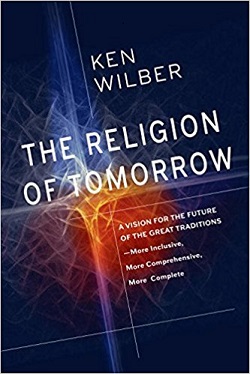 Hardcover, Shambhala, 2017, 806 pages.
Hardcover, Shambhala, 2017, 806 pages.
So it seems opportune to first give some background on this rather esoteric concept of involution, both within the context of Wilber's larger oeuvre, as well as by looking at how it has been interpreted in other esoteric or traditionalist schools of thought, before we dive into the details of this doctrine and its critical evaluation. As Wikipedia explains the esoteric meaning of "involution": "The term involution refers to different things depending on the writer. In some instances it refers to a process that occurs prior to evolution and gives rise to the cosmos, in others an aspect of evolution, and still others a process that follows the completion of evolution in the human form." The involution concept is elaborated in the esoteric schools of Theosophy, Anthroposophy and Rosicrucianism, in the philosophy of Sri Aurobindo (1872-1950), a source frequently cited by Wilber, and various other spiritual teachers such as Meher Baba and G. I. Gurdjieff. It can also be found in the works of the Indian scholar Anand Coomaraswamy (1877-1947). And, finally, involution is a foundational concept in the integral philosophy of Ken Wilber. Coomaraswamy features in Wilber's first book The Spectrum of Consciousness (1977).
Actually, in the 20th anniversary edition of this book, published in 1993, Wilber clarified why he has sometimes used the terms involution and evolution in different and completely opposite meanings:
Let me briefly mention one semantic point. The terms evolution and involution have been used differently by different authors, sometimes with diametrically opposite meanings. But the overall concept is simple: Spirit first "throws itself outward" to get "lost" in the manifest world of maya.... Spirit then begins the slow and torturous return to Itself, finally to awaken as Itself. Spirit is actually never "lost"; it is all a grand play (lila)...
Different writers use these terms in one of those two opposite ways, and the results can be confusing. But they are all talking about these two simple "movements": away from Spirit and toward Spirit. Now, in this volume [The Spectrum of Consciousness] I used evolution to mean "the movement away from Spirit" (the "unfolding of maya") and I used involution to mean "turning back toward Spirit." In doing so, I was following Coomaraswamy. In subsequent writings, I reverted to the other usage, following Aurobindo: involution is the move away from Spirit, getting lost and involved in maya, and evolution is the growth back to Spirit as Spirit, whereupon it is seen that all of maya is simply Spirit at luminous play. But this is entirely a semantic issue. (p. xviii-xix)
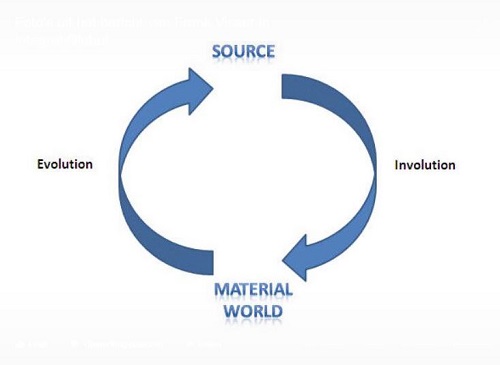
The involution/evolution cosmology as taught by many spiritual traditions.
So the basic idea is simple: in this view of things, evolution presupposes and is preceded by involution. Put differently, as "something cannot come out of nothing", as the saying goes[1], evolution must have been proceeded by some mysterious process in which all future complexities are foreshadowed. Many spiritualist evolutionists reason that, since evolution is characterized by the emergence of ever more complex and conscious forms of life, there has to be a "something" that has produced these evolutionary potentials hidden in the depths of unconscious matter.
Just think of it: there was a time there were no human beings. Or further back: no animals, no plants. Or even further back: no life. Where has all this magnificent variety of life forms come from? Or still fundamental: how could conscious spirit arise from non-consciousness matter? Wilber has often pointed out that even the progression from Hydrogen to the heavier and more complex elements points in the direction of a transcendental cause. Many spiritually included people nowadays refuse to believe in the simple creationist answer that "God created it". Does Wilber offer a more sophisticated, if still mystical-creationist philosophy? Is the choice we have really only between a divine special creation of all species, or blind chance alone? Both seem not very credible to the modern mind-set. Spiritual evolutionists such as Ken Wilber believe there is such a Third Way between vulgar creationism and crass materialism.
As Wilber phrases the problem in one of his early books, The Atman Project (1980), in the last chapter called "Involution" (which, however, deals more with the reincarnation process as envisioned by the Tibetan Book of the Dead):
According to the perennial philosophy, in order for evolution—which is the unfolding of higher structures—to occur at all, those higher structures must, in some sense, be present from the start: they must be enfolded, as potential, in the lower modes. If not, then evolution is nothing but creation ex nihilo, out of nothing. And, as theologians have long known, out of nothing you get nothing—ex nihilo nihil fit. And the story of involution is simply the story of how the higher modes came to be lost in the lower—how they came to be enwrapped and enfolded in the lower states. Involution, or the enfolding of the higher in the lower, is the pre-condition of evolution, or the unfolding of the higher states from the lower. (p. 160-1).
A few pages later, this is followed by a very strong statement, vintage Wilber:
One cannot, logically, ontologically, or metaphysically derive the higher from the lower. The higher modes can emerge because, and only because, they were enfolded, as potential, in the lower modes to begin with, and they simply crystallize out and differentiate from the lower modes as evolution proceeds. (p. 174-5)
Make no mistake about it: this is a deeply religious and spiritual view of reality, in which Spirit is the source out of which everything has come forth (during involution) and into which everything will return (during evolution). In Wilber's interpretation of this philosophical doctrine, Spirit is not only the source and the goal, but also the driving force behind this whole cosmic drama. This is the reason why his brand of spirituality is often called "evolutionary"—a misnomer, in my opinion, given Wilber's scant knowledge of evolutionary theory.
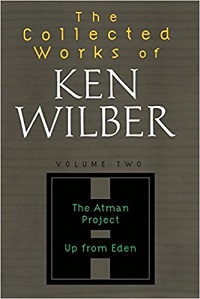
At the end of the Introduction to Volume II of The Collected Works of Ken Wilber (1999)—which contains the full text of The Atman Project and in which he reflects on this early period of his writing career—we find the following concluding statement on involution. In this statement, embodying Wilber's deepest convictions, he suggests that this notion of involution might even throw much light on many of the thorny scientific questions of how the evolution of complex biological and cultural forms has become possible in the first place:
I think of involution, then, along the analogy of a rubber band: stretch it, and you have involution, which supplies a force (namely Eros) that will then pull the two ends of the rubber band (matter and spirit) back together again—in other words, an involutionary force that will pull evolution along. But the actual route taken in that return, and all its wonderful variety, is a co-creation of every holon and the currents of Eros in which it fluidly floats.
Now, of course, you are perfectly free to believe in evolution and reject the notion of involution. I find that an incoherent position; nonetheless, you can still embrace everything in the following pages about the evolution of culture and consciousness, and reject or remain agnostic on involution. But the notion of a prior involutionary force does much to help with the otherwise impenetrable puzzles of Darwinian evolution, which has tried, ever so un-successfully, to explain why dirt would get up and eventually start writing poetry. But the notion of evolution as Eros, or Spirit-in-action, performing, as Whitehead put it, throughout the world by gently persuasion toward love, goes a long way to explaining the inexorable unfolding from matter to bodies to minds to souls to Spirit's own Self-recognition. Eros, or Spirit-in-action, is a rubber band around your neck and mine, pulling us all back home. (p. 12)
 Volvox, a colony of thousands of cells. (Wikipedia)
Volvox, a colony of thousands of cells. (Wikipedia)
Magnificent as these philosophical or spiritual vistas might be, it is obvious from the start that science frowns at these apodictic statements about how complex life forms can emerge: "because, and only because, they were enfolded, as potential, in the lower modes to begin with". Will the notion of involution really "help with the otherwise impenetrable puzzles of Darwinian evolution, which has tried, ever so un-successfully, to explain why dirt would get up and eventually start writing poetry." Here writes Wilber the creationist, who isn't really interested in how things came about during the billions of years of evolution. Perhaps—just perhaps—dirt first formed cells, and cells formed multi-cellular proto-organisms, and so on? It is the patient unraveling of these details that gives science its grandeur, not the easy proclamations of a spiritualist claiming deeper knowledge. It requires a patience, and a deep interest in Nature's workings, that Wilber doesn't seem to have.[2] Ken Wilber is only interested in science insofar its supposed failures to explain emergent complexity prove his point that there's "an Eros in the Kosmos".
It is also clear from the start, that this is the Achilles-heel of this integral-spiritual outlook on life and the cosmos. How coherent is the notion of involuton actually? What if science can explain or make understandable how "higher" forms of life emerged form "lower" forms, without any necessity of invoking mysterious cosmic forces like Spirit or intricate mechanisms such as involution and (spiritually understood) evolution? The whole system will come tumbling down, it will lose all of its dynamic powers. Involution provides Wilber with an apparently convincing explanation for the bewildering variety of cosmological and biological processes—still to be fully explained by materialistic science.
But I am getting ahead of my story.
A Theosophical Digression
In the last chapter of my book on Wilber, Ken Wilber: Thought as Passion (2003), I highlighted the fact that Wilber's embracing of the concept of involution sets him apart from many contemporary writers[3]:
Wilber stands out from the majority of his colleagues in the transpersonal world because he has no reservation in espousing the doctrine of involution (though he now prefers to speak of "involutionary givens"). Probably more then anything else, it is this that stands in the way of his vision being accepted by the scientific community, but in my opinion the doctrine of involution is an essential aspect of any complete metaphysical worldview. (p. 281)
I also criticized Wilber, however, in that book section, for his rather vague understanding of the nature involution (understandable since he had used only Coomaraswamy and Sri Aurobindo as sources). From a Theosophical point of view, a much more precise analysis would be possible—and since we are at it now, let's dive into some of these esoteric intricacies. According to Theosophy many different metaphysical processes can loosely be described as movements "from Spirit to matter" or "from matter back to Spirit". These are related to the Trinity as understood in theosophical theology in interesting ways:
- The process of creation or emanation that gives rise to the various worlds, planes or spheres of cosmological existence, from the highest spiritual realms to the densest material worlds. These worlds are created by Spirit in its Third Person of Brahma or Spirit. Without this deed of creation matter would be only an amorphous whole.
- The process by means of which these spheres are successively suffused with divine Life, from the highest sphere to the lowest (involution), which is then followed by reversal as life begins to move upwards through the spheres again in order to be able to return to its Source (evolution). Only the first, descending part of this cycle can strictly speaking be called "involution". This so-called Live Wave comes from the Second Person of Vishnu or the Cosmic Christ.
- The process in which an individual, spiritual Self or Ego is formed by individualization through an outpouring from above of the First Person of Spirit (Shiva or Father), into a so-called animal group soul. From that moment on, reincarnation as an individual entity is seen as possible (and a reincarnation into the animal kingdom is deemed to be impossible according to Theosophy).
- And finally there is the descending movement by means of which the spiritual Self or Ego creates a new personality for itself for each incarnation, before connecting itself (incarnation) to a new physical body. (p. 281-2)
There are interesting parallels and differences between this esoteric philosophy and Wilber's worldview, but we will pass over them quickly, for that is not the aim of this essay. First, in Wilber's presentation the creation of the world(s) seems to be equated to the process of involution proper—the seed is no longer sown in the fertile earth, it somehow creates this earth in the process. And when he is discussing the Tibetan Book of the Dead, in the last chapter of The Atman Project (strangely called "Involution"), he seems to fuse these post-mortem process to those of mystical growth and transformation. For Wilber, it is all "simply" a matter of going "up or down", painted with a very broad brush. Supposedly, after death we will rise up all the way to the level of Absolute Spirit—when we are capably of living on these lofty heights, or we will reincarnate again.[4]
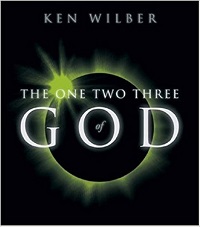
Secondly, Wilber has introduced the concept of "the 1-2-3 of God" in recent years (2006), to clarify the many dimensions of Divinity he acknowledges. On Amazon it is advertised as follows: "Is it possible to develop an all-inclusive embrace of God, one that can satisfy scientists, philosophers, and priests at the same time? It is, teaches best-selling author Ken Wilber, if you are able to understand The 1-2-3 of God. According to this premier modern philosopher, the seemingly innumerable ways humans conceptualize God can actually be broken down into three basic perspectives." The Third Person of God is represented by the material world, which science studies and explores. The Second Person of God is the Mystery of existence, with which we can form an intimate relationship. And the First Person of God is then the Self hidden in the deepest recesses of our consciousness, which we discover through meditative practice. This approach is playful and simple to understand, but lacks the precision and the informative power of the more traditional theosophical views, in my opinion.[5]
Wilber's current view of involution
Be that as it may, we are after something else. What are we to make of this esoteric concept of "involution", which turns out to take such a central place—though rarely discussed and reflected on—of Wilber's philosophy? To prove my point and give you an impression of how Wilber uses this concept, I will quote below freely from his latest book The Religion of Tomorrow (2017):
Once involution/Efflux is complete—and blows matter into existence with the Big Bang—then the reverse process of evolution/Reflux occurs. (p. 28)
This entire movement ‘outward’ and ‘downward’ to create a universe is called involution. Plotinus referred to it as Efflux (the superabundant ‘overflow’ and ‘outpouring’ of Spirit). (p. 148)
Whatever you might think of this theory of involution/evolution, or Efflux/Reflux, it certainly solves the problems of where the Big Bang itself came from, and how higher forms manage to emerge from lower forms, a perpetual puzzle to philosophers and scientists alike. ‘You can't get the higher from the lower’ is a common refrain you hear when philosophers and scientists discuss this issue, but this theory takes care of that problem: the higher emerges ‘out of’ or ‘through’ the lower in evolution because it was put there in involution, which is the creation of ‘the lower from the higher,’ which involves no theoretical problems at all. (p. 149)
Integral Theory takes the idea of involution/evolution and reduces to a minimum the number of forms said to be created during involution (in a metaphysical realm existing prior to the Big Bang) and leaves more of their form and content to being created during evolution (after the Big Bang and in this realm). (p. 149)
Thus, Integral Theory postulates a bare minimum of forms and events that were created during involution and sees most forms instead as produced by the forces and processes of evolution itself, which are open to evidence and scrutiny. (p. 150)
Most of the ‘metaphysical’ forms of the traditionalist theory of involution/evolution are extremely strict—involution created everything on every level of existence: physical particles; all forms of cells, and all forms of plant life, and all forms of animal life, with all their physiological processes; all forms of human culture, and all of its products, including all types of technologies and technological products, medicines, types of architecture, forms of law, types of poetry; all the ‘beings’ in all the realms (gods, goddesses, asuras, devas, elemental spirits); all the books ever written; all the languages ever produced; every form of mathematics and logic; and so on and so on and so on. ALL of those were produced during involution and hidden in the higher unconscious, and evolution is nothing but an unfolding of those already created forms that are lying in our unconscious, or in Spirit, and awaiting their turn to emerge. In this view, evolution is just a rewinding of the involutionary videotape—nothing comes out in evolution that wasn't put in there by and during involution. But not only more modern forms of science but higher integral forms of thinking themselves have suggested that evolution is a much more creative process than previously pictured by the traditions, and that much of what was thought to have been created by involution is actually created by and during evolution. (p. 150-1).
We only need original causal archetypes for the fundamental forms and processes that are necessary to get a universe going in the first place—things like space, time, and basic form, and instead of a specific number and types of levels of being, just one large force stretching from matter to Spirit, a force called ‘Eros’ and responsible for the pull of the reverse trip from matter to Spirit. Eros is a self-organizing force responsible for the ceaseless drive to higher and higher wholes, which are created by evolution itself, not involution. (p. 150)
This process is rather like what happens when one lets go of a rubber band with a rock on one end that has been stretched to its limits. The rock will, through an unpredictable swinging motion, slowly return to its original position. So too, the forms that emerge through evolution will slowly return, through all the grades of separation to Spirit itself, with the actual details of these many unpredictable swings determined by the numerous forms, processes, and patterns created by the return swings, by evolution itself, which Erich Jantsch defined as ‘self-organization through self-transcendence,’ an excellent definition. We don't need involution to create all these forms; evolution can do it itself—and this theory is one that can be accepted by modernity and postmodernity. (p. 151)
This Eros, or evolutionary drive, when combined with fundamental forms like the 4 quadrants, the form of holons, and space-time itself, creates a ‘transcend-and-include’ movement to ever-higher, ever-more conscious, ever-more complex holonic forms—interior and exterior, individual and collective—from matter through life through mind through soul to Spirit itself. The original force in the stretching of the rubber band (an ‘involutionary given’) will provide all the force required to create the different characteristics (forms on all the different levels) of each swing of the returning rock. (p. 151)
Thus you don't need to postulate such pregiven, eternally fixed, meta-physical elements anyway—whatever the phenomena are, evolution could have produced them just as easily as involution, but without all the metaphysical ontologies and otherwise unprovable assumptions. (p. 152)
Taking a bird's eye view of Wilber's oeuvre through the past decades, we see the following.
First, Wilber creates a straw man of the traditional view of involution. He never gives sources or examples, as usual, but plainly states that traditionalist sources have been very "strict" in stating that everything that has emerged, or can emerge, in evolution, must have been present in some form during involution—including physical particles, biological life and cultural productions (even to the level of computers, cellphones and iPhones. And since no mystic has ever spotted iPhones in his introspecton, according to Wilber this strong version of involution can't possibly be true. A truly weird argumentation!). I don't think that anybody holding on to a notion of involution in past or recent times have every believed such a thing.[6]
But Wilber needs this view-held-by-nobody to be able to then present his own, "up to date" version of the involution doctrine, which supposedly is acceptable to modern or postmodern ears because it has stripped away all of the metaphysical baggage, to retain only one simple tenet:
We only need... just one large force stretching from matter to Spirit, a force called ‘Eros’ and responsible for the pull of the reverse trip from matter to Spirit. (p. 150)
This "one large force", however, will never be acceptable to modernity or postmodernity. It is just a question-begging, sanitized version of "God-did-it". It lacks any precision or specification (where is this force active?, how strong or weak is it actually? why does it seem to fail on planets other than our Earth, with it's life-friendly geological and atmospheric conditions?, etcetera, etcetera) to be able to compete with the more conventional four forces of nature. Wilber believes that the modern mind can accept the idea that evolution shows an increasing trends towards higher stages of complexity and consciousness, but the mechanism behind this (even if the general trend might be accepted) is hotly debated.
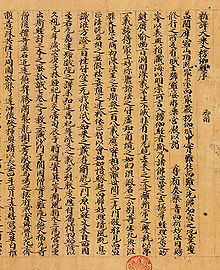 The Lankavatara sutra from Dunhuang
The Lankavatara sutra from Dunhuang
Secondly, for Wilber involution seems to be related primarily to the creation of the cosmos, up to the level of the Big Bang and the genesis of all the subatomic particles, instead of being just one element of the cosmic puzzle. This can be confusing, for his terminology is often psychological: Spirit creates soul, which creates mind, which creates life, which ultimately creates matter. His main source here is the famous Buddhist Lankavatara Sutra, a sutra of Mahayana Buddhism. Wikipedia: "The Lankavatara Sutra describes the various tiers of consciousness in the individual, culminating in the tathagatagarbha (womb of the Buddhas) or "storehouse consciousness" (Skt. Alayavijñana), which is the base of the individual's deepest awareness and his tie to the cosmic." This confusion of psychological and cosmological dimensions (Wilber would most probably prefer to say "integration") is typical for his writings. So besides providing the necessary "engine behind evolution", the concept of involution also offers to Wilber an "explanation" for how the physical cosmos came into existence—not a line of thought scientists would want to pursue.
And thirdly, the key argument he gives for rejecting most of the traditional notions of involution—leaving aside for the moment the question if these notions were ever held by anyone—is both interesting and revealing: we don't need involution to explain all these evolutionary emergences, he assures us, because
... not only more modern forms of science but higher integral forms of thinking themselves have suggested that evolution is a much more creative process than previously pictured by the traditions, and that much of what was thought to have been created by involution is actually created by and during evolution. (p. 150-1)
Now this is really ironic—but also somewhat disingenuous—for these very same modern forms of science have found out that it doesn't take such a force of Eros to explain any of the diversity of life! Why not take a second, and decisive step and, after stripping involution of much of its metaphysical baggage, also do away with this "skyhook" (Dennett) of Eros which supposedly explains evolutionary complexity, but does nothing of the kind? These "higher integral forms of thinking" may have finally become aware of the creativity of the evolutionary process—for a true explanation of this diversity it still needs to listen to and learn from science.
But, what gimmick is this rubber-band theory of involution and evolution, that pulls us back to where we came from? How far can you get from a viewpoint that is "open to evidence and scrutiny"? If Wilber has proven one thing in his dealings with science (and evolutionary theory in particular) it is that he could not care less about the struggles of science to discover the laws of reality, as long as they confirm his pre-conceived notions of a cosmic and evolutionary Spirit. Will it seriously be considered as theoretical progress, if we proclaim that the origin of subatomic particles can be explained because they have been laid down by involution? Will that satisfy anybody working at CERN? A solution, no less, "which involves no theoretical problems at all." Seriously?
Still, Ken Wilber means serious business when he introduces the concept of Eros—one only wonders what he means by "theory":
Modern science now believes that evolution touches essentially everything in existence (even though it is lagging behind theoretically on exactly how to explain this)...
You can even see evolution as driven by "Spirit-in-action," which I think is the only theory that can actually explain the mysteries of evolution satisfactorily. (p. 14)
This is in my opinion the real problem. Wilber proclaims confidently,
‘You can't get the higher from the lower’ is a common refrain you hear when philosophers and scientists discuss this issue. (p. 149)
I am afraid Wilber hasn't really listened to what philosophers and scientists are saying and doing, when they struggle to understand the facts of physical and biological reality. He must be hearing his own opinions, as he has consistently expressed them now for over forty years of writing.
Conclusion
To summarize, Ken Wilber claims, as expressed in his latest book The Religion of Tomorrow—but effectively since many decades—that, to explain evolution (and mind you: that is the original goal of all this traditional and modern reflection), we no longer need the strong involution claims of the traditions, but we still need some sort of weak involution model, including the "upward pull" of Eros. Science, by contrast, claims we need nothing of the kind, because that approach is completely question-begging. Carbon and Oxygen were not somehow "in the works" the moment that still only Hydrogen existed. Nor were plants, animals or humans. Nor computers, cellphones and iPhones. The involution/evolution model is therefore a completely outdated way of explaining what happens during biological and cultural evolution.[7]

“I think of involution, then, along the analogy of a rubber band.”
NOTES
[1] This view is contested brilliantly in: Lawrence Krauss, A Universe from Nothing: Why is There Something Rather than Nothing, Free Press, 2012. It seems our notions of "nothing" have evolved quite a lot since the theological times.
[2] A good anti-dote to Ken Wilber's broad-brush anti-reductionistic agenda is Daniel Dennett's From Bacteria to Bach and Back: The Evolution of Minds (W. W. Norton, 2017), in which he explains this difference between asking "what is it for" and "how did it get there." He gives an interesting treatment of the role played by purpose in evolution, and steers a middle course between those who take apparent purpose as proof of creation, and those who want to ban all purpose-talk from biology. According to Dennett, purpose evolves, and we can often take an "intentional stance" towards biological organisms, as if they know exactly that they are doing—which according to Dennett is most often definitely not the case: they show "competence without comprehension". But that's for another essay.
[3] Please note that when writing this book, during the years 1997-1999, I myself was a staunch believer in the esoteric/occult view of the world, about which I had written the book Seven Spheres (1995). At that time, I literally knew nothing about what evolution means in the scientific sense (the 2009 Darwin year changed that completely). I had even used this particular esoteric perspective to critically evaluate these more obscure aspects of Wilber's integral philosophy. In the next two decades, after deeply researching the field of evolutionary theory, I reached a tipping point and changed my mind, and worldview—contrary to Ken Wilber—about the nature of evolution. From then on, I have criticized Wilber on many occasions for his misunderstanding of evolution.
The reader may judge for him- or herself what is more valuable: to be consistent over four decades, like Ken Wilber, when it comes to evolution (and involution), or to change one's mind when confronted with empirical evidence, as in my own case.
[4] Those interested in these esoteric teaching can still consult some online chapters of my book Seven Spheres on Integral World: "Spheres upon Spheres", "Three Models of Immortality" and "Reincarnation and the Spheres"
[5] Wilber's first (The Spectrum of Consciousness, 1977) and third book (The Atman Project, 1980) were published by The Theosophical Publishing house as Quest Books. The ideological affinity between Theosophy and Ken Wilber is still something to be documented in more detail.
[6] In the Theosopical tradition, for example—which I know best and is the most detailed in this respect—involution is seen as a preparatory stage, in which the materials are "woven" that are used during evolution by the various "kingdoms" of minerals, plants, animals and humans to form their bodies (both physical and subtle). Spiritual monads—the smallest units of consciousness—are attached to matter during this involutionary process, but slumber during eons of time until evolution has proceeded enough for them to take ownership of physical (and more subtle) bodies.
As Annie Besant writes in A Study in Consciousness: A Contribution to the Science of Psychology (1904) about this process: "In the upward sweep [of evolution] we shall find that bodies are built out of the matter thus prepared." (p. 59). In the same book we find the statement so characteristic of all these "spiritual evolutionists": "It is this involution of Spirit which makes evolution possible." (p. 18). More detailed information about this world view can be found in the compilatory work A. E. Powell, The Causal Body and the Ego (1928). From which: "All this downward sweep of the life-wave through the planes, giving qualities to the many grades of matter, is a preparation for evolution, and is often, and more properly, called involution." (p. 19)
[7] The Religion of Tomorrow, which runs to 806 pages, contains of course much more than I discussed in this brief essay, which discusses only one foundational integral concept. It is also a very technical book, and I mean that as a compliment. When Wilber sticks to what he knows best—the intricacies of the psycho-spiritual domains, their pathologies and remedies—his writing is interesting, truly original and sometimes even inspiring. But when he touches on the wider fields of science or metaphysics—"the universe according to Wilber"—I am no longer on board. A truly post-metaphysical spirituality covers the mystical states and stages of consciousness human beings are capable of. That's all well and fine. But we shouldn't draw any far reaching conclusions from these experiences to "how the world as we know it came about", for that would be asking too much of a map of human consciousness and culture.
|

 Frank Visser, graduated as a psychologist of culture and religion, founded IntegralWorld in 1997. He worked as production manager for various publishing houses and as service manager for various internet companies and lives in Amsterdam. Books: Ken Wilber: Thought as Passion (SUNY, 2003), and The Corona Conspiracy: Combatting Disinformation about the Coronavirus (Kindle, 2020).
Frank Visser, graduated as a psychologist of culture and religion, founded IntegralWorld in 1997. He worked as production manager for various publishing houses and as service manager for various internet companies and lives in Amsterdam. Books: Ken Wilber: Thought as Passion (SUNY, 2003), and The Corona Conspiracy: Combatting Disinformation about the Coronavirus (Kindle, 2020). 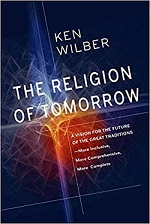 Frank Visser, CLIMBING THE STAIRWAY TO HEAVEN
Frank Visser, CLIMBING THE STAIRWAY TO HEAVEN





